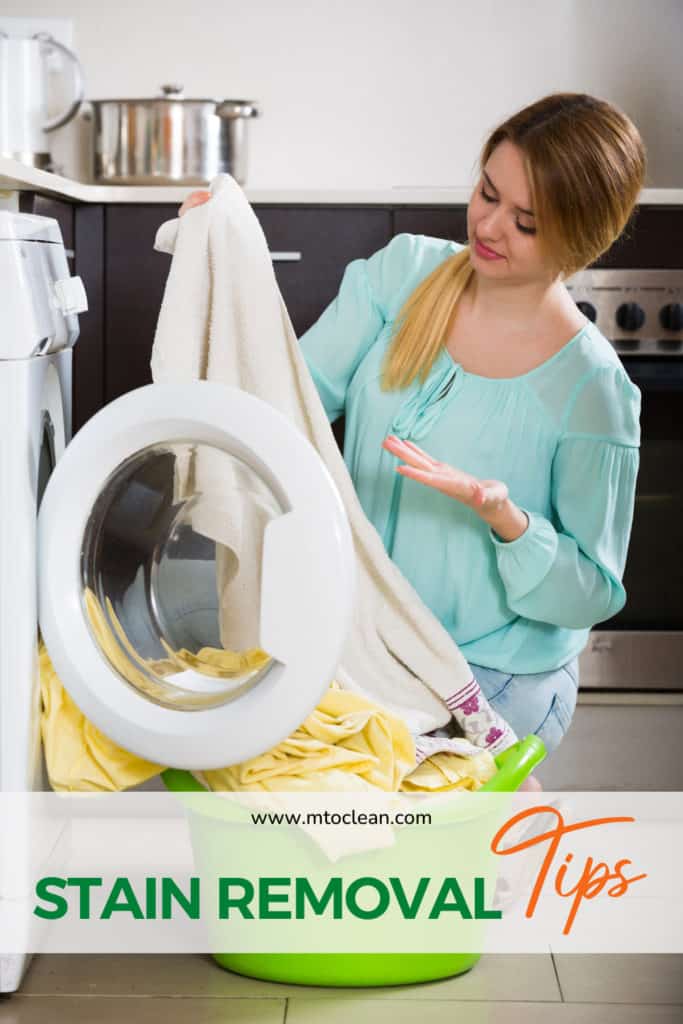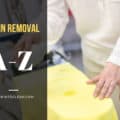On this page, you will find stain removal tips for clothes & fabrics, carpets, and upholstery. After these specific tips, I have included a section on general Do & Don’t Spot Removal Tips. It’s a good idea to check out my page on Laundry Spot Removal Tips because doing your laundry the wrong way can permanently set existing stains, and even create a few new ones.
Stain Removal Tips for Clothes and Fabrics
Read care labels to see if the article is dry-clean only or wash only.
Treat stains promptly. Fresh stains are easier to remove than old ones. If the stain is on a non-washable fabric, take it to the dry cleaner as soon as possible. Point out the stain and explain what it is so that it can be treated accordingly.
Use cleaning products according to manufacturer’s labels.
Testing for colorfastness is recommended before using any kind of bleach or strong cleaning product. To test, apply the cleaning agent to an inconspicuous area of the garment, such as an inside seam. Let stand for 2-5 minutes, then rinse. If color changes, do not use product on garment.
See also:
When using bleach, do not try to bleach just one area of garment; bleach the entire garment to prevent uneven color removal.
When treating, place stained area face down on a clean paper towel or white cloth. Apply stain remover to the underside of the stain, forcing stain off the fabric surface instead of through it.
Never put chemical dry-cleaning solvents directly into washer.
Thoroughly rinse and air dry areas treated with dry-cleaning solvents before placing in washer. This stain removal tip will help to avoid a fire.
Do not mix stain removal products together. Some mixtures, such as ammonia and chlorine bleach, produce hazardous fumes.
Always launder washable items after treating to remove residues of the stain and stain remover.
Have patience – it takes a little extra time and effort to remove some stains.
Remember, some stains cannot be removed.
For more information, see these pages on Clothing Spot Removal Tips and Fabric Spot Removal Tips.
Carpet Stain Removal Tips

1. When anything is spilled on carpet surface, removal results are best when stain is treated immediately, before it dries.
2. Apply cleaning materials directly to stain in the order listed. Blot in an inconspicuous spot and test for 10 seconds before using a solvent or cleaning materials.
3. Do not rub stain, always blot with clean absorbent white cloth or paper towel.
4. Avoid getting carpet too wet.
5. Once the carpet is dry, gently brush or vacuum the area to restore its pile and glory.
6. Some stains are very hard to remove and you may need to repeat the process 2 or more times. Some stains are permanent and cannot be removed.
For more information, see this page on Carpet Spot Removal Tips.
Stain Removal Tips for Upholstery
Remove excess soil promptly, by scraping off residue with dull knife or spoon, and/or blotting up spills with absorbent materials.
Be sure to pretest in an inconspicuous spot. Basically, fabrics are cleanable if they don’t fade or shrink.
Do not remove cushion from the cover.
No harsh rubbing – use soft white cloth or a sponge.
Rinse with a damp sponge.
Rapid drying is essential.
Symbols and their meanings – found on upholstery labels or tags, read tag on furniture:
W – Spot-clean with the foam only of a water-based cleaning agent such as mild detergent or upholstery shampoo.
S – Spot-clean using solvent only. Use sparingly in a well-ventilated room. Use of water-based solvent cleaners may cause spotting and/or excessive shrinkage. Water stains may become permanent.
S-W – Spot clean with solvent or water-based foam.
X – Vacuum only.
For more information, see this page on Upholstery Spot Removal Tips.
Do and Don’t Stain Removal Tips
It may seem contradictory, but speed and patience are the key to stain removal success. When a spill happens, you need to act quickly to minimize the damage, but you also need to appropriately and patiently apply the treatment that’s most likely to prevent the spill from becoming a stain. In short, you need to hurry up and take your time. Don’t worry, it’s not as impossible as it sounds.
If the old saying about never getting a second chance to make a first impression is true, then the stain treatment corollary should be, “You never get a second chance to remove a first impression.” Of course, that’s not entirely accurate, as you’ll find a number of second- and third-chance treatment options, but first treatments, like first impressions, always make – or in this case, reduce – the biggest mark. The following are some key do and don’t stain removal tips:
Do Use a Light Touch
It’s tempting to put some muscle into your stain-removal efforts, trying to rub and scrub at a spot until it’s driven away by force. A heavy hand on all but the sturdiest surfaces, however, can cause damage that remains even after the stain is gone. Rubbing fabrics (including carpet and upholstery) frays the fibers and makes them “fuzz up.” You may remove the stain, but you’ll likely leave behind damaged fibers that stand out nearly as much. Such fibers are not only prone to collecting dirt, but they’re also likely to wear out more quickly and make a hole.
Do Treat Stains When They’re Fresh
Don’t wait until laundry day rolls around. Nearly every stain you encounter is easiest to remove when it’s fresh. In fact, much of the success of removal methods involves keeping spills from ever becoming stains by cleaning them up as quickly as possible and using solutions that dissolve them away instead of setting them in. This is one of the most important stain removal tips.
Do Keep Dry Spills Dry and Wet Spills Wet
Imagine shampooing a heavily soiled carpet without first vacuuming it thoroughly to pick up the loose dirt. In a very short time, you’d have a wet, muddy mess, and the cleaning solution would only serve to drive the soil deeper into the carpet fibers. Don’t put a drop of liquid on a dry spill (or mark) until you’ve vacuumed, shaken, brushed, or blown away every particle you possibly can. Then – and only then – should you consider using a liquid treatment to remove any dye transfer.
As for the stain removal tip of keeping wet stains wet, remember that like dissolves like. If liquid carried the stain onto the surface, it’s likely that liquid will carry it off. Drying a liquid stain only takes away its transportation and leaves the dyes and solid materials to cling tightly to your stuff.
Don’t Rub It In
When a staining agent gets on an item, the goal is to remove it, ideally before it leaves a stain. Avoid the urge to wipe, rub, or otherwise press on solid and semi-solid spills; you’ll only force them into the surface they’re trying to stain, and you’ll be left trying to force them back out. With a lifting motion, wield a spoon, a dull knife, a spatula, or even a credit card to carefully scrape the spill off your stuff. Whatever the stain is made of, it’ll be so much easier to remove completely if you keep it superficial.
Do Work in Good Lighting
This stain removal tip is mostly a laundry room recommendation. If the lighting in your laundry room is inadequate or distorts color perceptions, you’re likely to miss seeing stains that have been waiting for laundry-day treatment, and you’ll have a hard time determining whether your stain-treatment efforts are successful or not. Install bulbs that deliver natural-looking light. Add a light fixture or a lamp to chase away shadows that can hide stains from clear view. When treating a stain that’s fallen outside the reach of your home’s lighting fixture (e.g. a carpet stain in the corner of a room) temporarily position a lamp at the location of the stain.
Do Know Your Garments
When faced with a spill and potential stain, ask yourself these questions: what solution will dissolve the staining agent? What solutions are safe to apply?
It does little good to remove a stain from your favorite wool sweater if the ammonia solution you use irreparably damages the fibers. Fortunately, knowing the fiber content of garments is usually as easy as checking the content label. Most garments also have a fabric care label that tells you the recommended water temperature for washing, whether it’s safe to use bleach, and how to safely dry the garment.
Do Bring in “Back-Up”
This stain removal tip applies to treating stains on fabrics. Always place an absorbent pad under the stain to soak up the staining material and soiled cleaning solution as it moves out of the fabric. If you don’t make a habit of doing this, you run the risk of removing a stain from one part of a garment and sponging it onto another. Refold or replace the pad frequently to keep the stain from reapplying to the surface you’re treating. Clean, light-colored towels and washcloths work very well for this, as do cloth diapers. Nearly any absorbent cloth will do, as long as it’s clean and colorfast. You can also make a pad with several layers of white paper toweling. It makes sense to keep a supply of clean, light-colored cloths or rags on hand for this purpose.
Do Get Under the Stain
It’s not always possible, but when you can, remember this stain removal tip and work from the underside of a spot on fabric. Assuming the stain landed on the outside of the fabric, treating it from the underside helps to push it off the surface instead of pushing it through. This lessens the chance that the stain will settle into the fabric’s fibers and also reduces the likelihood that you’ll abrade the surface of the fabric by rubbing the stained area. Simply lay your garment stain side down on a cloth pad, and treat from beneath.
Do Clean Out the Cleaner
When you’re through applying stain treatments to carpet or upholstery, be sure to rinse and blot the area with clear water. If you don’t follow this stain removal tip, the residue left by the cleaning solution will attract soil to the treated area, and instead of a stain, you’ll have a dirty spot. You may not need to rinse stain treatments out of washable items if the next step in the process is laundering. When switching from one treatment to another without laundering in between, it is important to rinse out the first treatment solution completely to avoid combining incompatible household chemicals that could release dangerous fumes or damage the item you’re treating.
Do Meet the Maker
If the stain in question was caused by a product, you may find that the best stain removal tips come from the product’s manufacturer. Start with the product label – it may tell you everything you need to know. In the absence of that information on the label (or in the absence of a label), visit the manufacturer’s website, or give its customer service department a call. Responsible manufacturers of products with a high potential for causing stains (think glues, paints, and children’s art supplies) have become quite sophisticated at providing this type of information.
Do Ask the Big Question
Treat it or toss it? This stain removal tip applies to spots that are difficult or impossible to remove. In those cases, you have to decide how much time and effort you want to invest in treating the stain. Oftentimes, the stain’s location makes the difference. Is it in the middle of your two-year-old living room carpet, or on the front of your twenty-year-old concert T-shirt? Although you may regret the loss of the shirt (or decide that a stain simply adds to its “vintage” look), it won’t cost hundreds of dollars to replace it (or require you to hide it with a piece of furniture) if it’s irretrievably stained.
Do Consider Seeking Professional Help
A stain that’s relatively easy to remove from washable fabric may require a much different treatment on a dry-clean-only garment. Stains on upholstery, too, may require professional treatment, especially if the upholstery fabric is not meant to be cleaned with water.
Don’t Give Up
This is a simple stain removal tip: tough stains may require repeat treatment, and you may have to vary your tactics until you find the right solution.
Don’t Spread It Around
It’s all too easy, in the excitement of a spill, to accidentally drip spilled liquid from blotting clothes across the carpet or to smear the spaghetti sauce beyond the margins of the original spot. As you scrape, lift, and/or blot, work from the outer edges of a stain inward to the center to avoid making a bigger stain. Do the same when you apply water or cleaning solutions – your goal is to make the stain smaller, then to make it vanish entirely. Don’t work against yourself.
Keep these stain removal tips in mind and you can’t go wrong!







